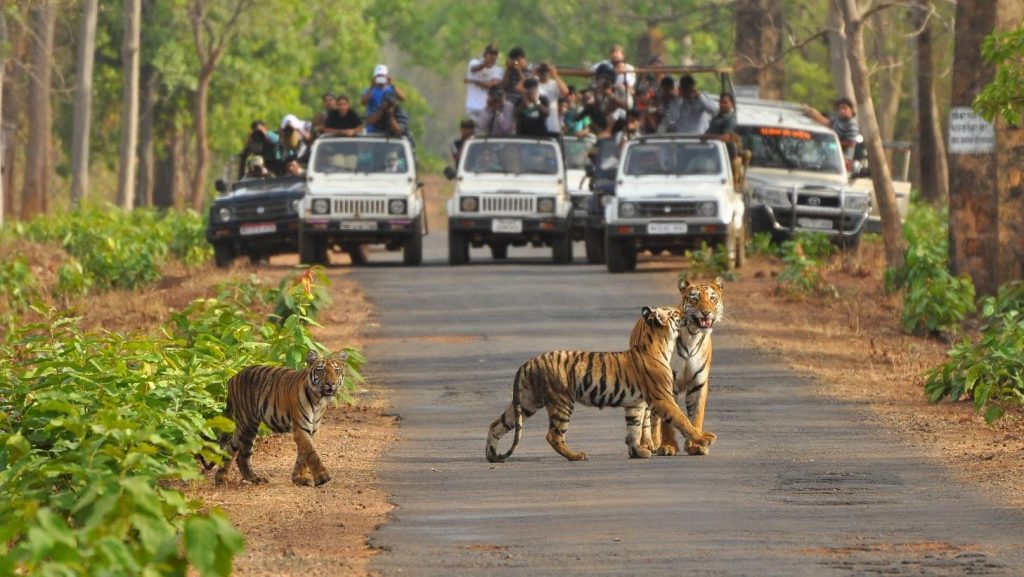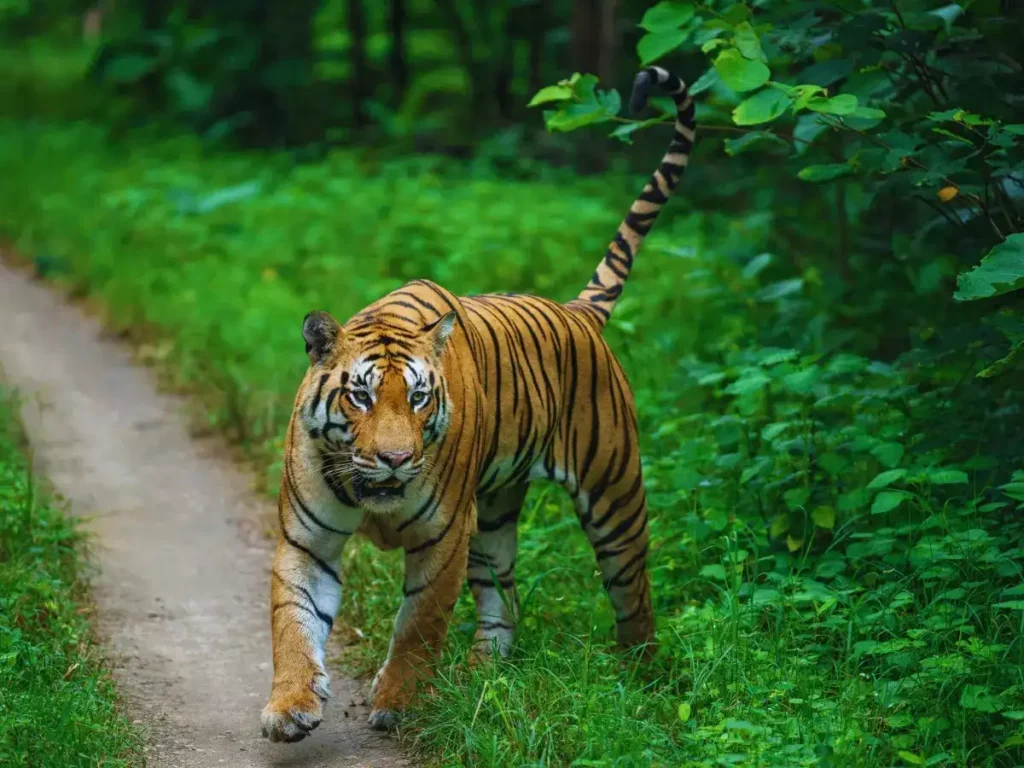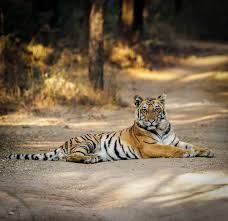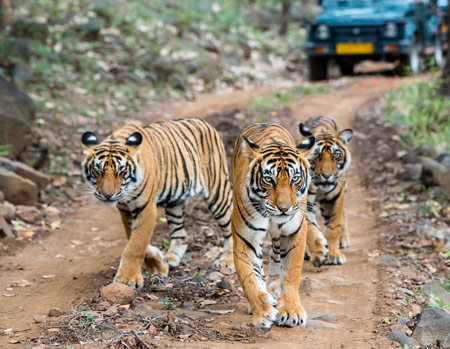
Table of Contents
Pench Tiger Reserve, Nagpur: A Haven for Wildlife and Conservation
Introduction

Pench Tiger Reserve, located near Nagpur, Maharashtra, is one of India’s most celebrated wildlife sanctuaries, known for its breathtaking landscapes, diverse flora and fauna, and thriving tiger population. Named after the Pench River, which meanders through the reserve, it spans across two states—Madhya Pradesh and Maharashtra—covering a vast area of 1,179 square kilometers. The reserve is a part of India’s Project Tiger, an initiative dedicated to the conservation of the majestic Bengal tiger and its natural habitat.
Pench Tiger Reserve is steeped in history and literary significance. The lush forests and abundant wildlife served as the primary inspiration behind Rudyard Kipling’s timeless classic, The Jungle Book. The novel’s iconic characters, such as Mowgli, Baloo, and Shere Khan, are believed to have been influenced by the landscapes and wildlife of Pench.
Beyond its connection to literature, Pench is a biodiversity hotspot with a thriving ecosystem that supports a variety of wildlife, including leopards, wild dogs (dholes), sloth bears, Indian gaur, spotted deer, sambar, and over 300 species of birds. Its well-preserved forests, primarily consisting of dry deciduous teak and mixed forests, provide an ideal habitat for both predators and prey, making it one of the best destinations for wildlife enthusiasts, photographers, and researchers.
With its stunning natural beauty, remarkable biodiversity, and strong conservation efforts, Pench Tiger Reserve stands as a symbol of India’s commitment to wildlife preservation and ecological balance.
History and Establishment of Pench Tiger Reserve
Pench Tiger Reserve, located in central India, is a renowned wildlife conservation area with a rich history and ecological significance. It was officially designated as a protected area in 1977, marking a significant step toward preserving its diverse flora and fauna. Recognizing its vital role in the conservation of Bengal tigers, the reserve was incorporated into Project Tiger in 1992, reinforcing efforts to protect and sustain the region’s tiger population.
The reserve is spread across two states—Madhya Pradesh and Maharashtra. The Maharashtra section, also known as Pench National Park (Maharashtra), was initially declared a wildlife sanctuary in 1983. Due to its growing importance as a biodiversity hotspot, it was later upgraded to a national park in 2019, further strengthening conservation measures in the area.
Pench’s historical significance extends beyond its role in modern wildlife conservation. The region’s dense forests find mention in Ain-i-Akbari, a 16th-century administrative document compiled during the reign of Mughal Emperor Akbar. This historical reference highlights the area’s long-standing recognition for its abundant natural resources and thriving wildlife.
Over the years, Pench has evolved into one of India’s finest tiger habitats, offering a safe haven for a wide range of species, including leopards, wild dogs, sloth bears, and numerous bird species. Its diverse ecosystem, combined with dedicated conservation efforts, has made it a premier destination for wildlife enthusiasts, researchers, and nature lovers.

Geographical Features
Pench Tiger Reserve boasts a diverse and picturesque landscape, characterized by dense forests, rolling hills, riverbanks, and open grasslands that create a thriving habitat for its rich wildlife. The reserve’s topography is shaped by the Satpura mountain range, and its ecosystem is sustained by the Pench River, which flows through its heart, ensuring a year-round water supply for flora and fauna.
1. Dense Deciduous Forests
The reserve is primarily covered in dry deciduous forests, with teak (Tectona grandis) as the dominant tree species. Other prominent tree varieties include Mahua, Tendu, Salai, and Indian Ghost Tree (Kullu). These forests not only provide shelter for tigers and leopards but also sustain herbivores such as deer and Indian gaur.
2. Hilly Terrains
The Satpura range, a prominent geological feature, runs through the reserve, offering a rugged and undulating landscape. The varying elevations contribute to microhabitats, allowing different species of plants and animals to thrive in specific zones. The hills also serve as vantage points for predators, especially tigers and leopards, while acting as a natural corridor for wildlife movement.
3. The Pench River – The Lifeline of the Reserve
The Pench River, a perennial water source, flows north to south, dividing the reserve into eastern and western sections. During the dry season, the river shrinks into pools and waterholes, which become critical gathering spots for wildlife. Several streams, nallahs (seasonal watercourses), and reservoirs supplement the water supply, supporting both aquatic and terrestrial species.
4. Grasslands and Meadows
Scattered grasslands and meadows break the dense tree cover, creating open spaces crucial for herbivores like chital (spotted deer), sambar deer, nilgai (blue bull), and Indian gaur (bison). These grasslands also serve as prime hunting grounds for apex predators such as tigers, leopards, and dholes (wild dogs).
5. Climate and Best Time to Visit
Pench Tiger Reserve experiences three distinct seasons:
- Summers (March to June) – Hot and dry, with temperatures reaching 40°C (104°F), making water sources vital for wildlife. Animal sightings are frequent near water bodies.
- Monsoons (July to September) – The reserve receives heavy rainfall, rejuvenating the ecosystem but making access difficult due to muddy trails and swollen streams.
- Winters (October to February) – Characterized by cool and pleasant weather (10°C to 25°C / 50°F to 77°F), making it the best time for safaris and wildlife sightings. The dense foliage thins out, improving visibility of animals.
The varied terrain, rich biodiversity, and seasonal transformations make Pench Tiger Reserve a captivating and dynamic ecosystem, attracting nature lovers, wildlife photographers, and researchers alike.

Wildlife and Biodiversity of Pench Tiger Reserve
Pench Tiger Reserve is a thriving ecosystem that supports a diverse range of flora and fauna, making it a paradise for wildlife enthusiasts, researchers, and nature lovers. The reserve’s rich biodiversity plays a crucial role in maintaining the ecological balance of the region.
Fauna
1. Bengal Tiger (Panthera tigris tigris)
Pench is renowned for its healthy population of Royal Bengal Tigers, with frequent sightings that attract wildlife photographers and tourists. The reserve has played a significant role in tiger conservation under Project Tiger. One of Pench’s most famous tigers, Collarwali, gained international fame for successfully raising multiple litters, contributing to the reserve’s growing tiger population.
2. Leopards and Other Predators
Apart from the majestic Bengal tigers, the reserve is also home to other formidable predators, including:
- Indian Leopards (Panthera pardus fusca) – Elusive and agile, these big cats are occasionally spotted in the reserve.
- Dholes (Cuon alpinus) – Also known as Indian wild dogs, these highly social and efficient hunters thrive in Pench’s forests.
- Sloth Bears (Melursus ursinus) – Nocturnal and primarily insectivorous, sloth bears are an essential part of the reserve’s ecosystem.
- Jungle Cats (Felis chaus) – Small yet skilled hunters, these cats are found in the dense undergrowth of the forest.
3. Herbivores
Pench supports a large prey base, ensuring a stable food chain for its predator population. Common herbivores include:
- Chital (Axis axis) – Also known as spotted deer, they are among the most commonly sighted herbivores in the reserve.
- Sambar Deer (Rusa unicolor) – The largest deer species in India, an important prey species for tigers and leopards.
- Nilgai (Boselaphus tragocamelus) – Also called the blue bull, it is the largest antelope in the region.
- Wild Boar (Sus scrofa cristatus) – These opportunistic omnivores play a crucial role in the ecosystem by foraging on plant matter and small animals.
- Gaur (Bos gaurus) – Commonly referred to as the Indian bison, this massive bovine species is a significant part of the food chain for apex predators.
4. Birdlife
With over 300 species of birds, Pench is a birdwatcher’s paradise. The reserve provides a habitat for both resident and migratory birds, including:
- Indian Pitta (Pitta brachyura) – A vibrant, ground-dwelling bird known for its striking colors.
- Crested Serpent Eagle (Spilornis cheela) – A formidable raptor that preys on snakes and small mammals.
- White-eyed Buzzard (Butastur teesa) – A medium-sized bird of prey commonly found in open woodlands.
- Malabar Pied Hornbill (Anthracoceros coronatus) – A striking hornbill species, playing an essential role in seed dispersal.
- Asian Paradise Flycatcher (Terpsiphone paradisi) – Known for its long, elegant tail and aerial acrobatics.
Flora
Pench’s landscape is characterized by Southern Tropical Dry Deciduous Forests, with a mix of moist riverine belts and open grasslands. The forest composition provides an ideal habitat for various wildlife species.
Dominant Tree Species
- Teak (Tectona grandis) – The most prominent tree species, forming dense canopies that offer shade and shelter.
- Mahua (Madhuca indica) – Known for its flowers, which are used in local beverages and traditional medicine.
- Tendu (Diospyros melanoxylon) – Its leaves are commonly used for making Indian beedis (hand-rolled cigarettes).
- Arjuna (Terminalia arjuna) – Found along riverbanks, this tree is known for its medicinal properties.
The reserve also has a variety of shrubs, grasses, and medicinal plants that contribute to the overall biodiversity and ecological stability of the region.

Tourism and Safari Experience
Pench Tiger Reserve offers an exhilarating wildlife experience, attracting adventure seekers, nature lovers, and photographers from around the world. The reserve provides opportunities for jeep safaris, nature walks, and birdwatching tours, allowing visitors to witness the diverse flora and fauna up close.
1. Safari Zones in Pench
The reserve is divided into multiple tourism zones, each offering a unique experience:
- Turia Zone (Madhya Pradesh) – The most popular safari zone, known for frequent tiger sightings, lush forests, and diverse wildlife.
- Karmazari Zone (Madhya Pradesh) – Offers picturesque landscapes and a rich biodiversity, making it ideal for nature enthusiasts.
- Rukhad Zone (Madhya Pradesh) – A less crowded zone, providing a peaceful safari experience with opportunities to spot leopards, sloth bears, and wild dogs.
- Sillari Zone (Maharashtra) – Located in the Maharashtra section of the reserve, this zone is ideal for shorter safaris and is accessible year-round.
- Khursapar Zone (Maharashtra) – A relatively smaller but wildlife-rich area, offering high chances of sighting big cats and other animals.
2. Best Time to Visit
The ideal time to visit Pench Tiger Reserve is from October to June, with each season offering a different safari experience:
- October to February (Winter) – Pleasant weather, lush green surroundings, and excellent opportunities for birdwatching.
- March to June (Summer) – Increased chances of spotting tigers and other wildlife near water sources. April and May are peak months for tiger sightings as the dry season forces animals into open spaces.
- July to September (Monsoon) – The core zone remains closed due to heavy rains, but buffer zones remain open for limited safari experiences.
3. Safari Timings and Booking Information
Pench Tiger Reserve offers both morning and evening safaris, as well as a limited night safari experience in specific buffer zones.
- Morning Safari: 6:00 AM – 10:30 AM (Best for spotting predators returning from their hunts.)
- Evening Safari: 3:00 PM – 6:30 PM (Great for watching animals as they become active during cooler hours.)
- Night Safari: Available in select zones, offering a unique opportunity to observe nocturnal creatures like leopards, owls, and civet cats.
4. Additional Activities
Besides jeep safaris, visitors can also enjoy:
- Nature Walks & Eco-Trails: Guided walks through the buffer zones allow tourists to appreciate the smaller wonders of the forest, such as butterflies, medicinal plants, and reptiles.
- Birdwatching Tours: Pench is home to over 285 bird species, including Indian Pitta, Malabar Pied Hornbill, and Crested Serpent Eagle.
- Village & Tribal Visits: Experience the local culture by visiting nearby villages and learning about the indigenous Gond and Baiga tribes.
Conservation Efforts in Pench Tiger Reserve
Pench Tiger Reserve is at the forefront of wildlife conservation, employing a multi-faceted approach to protect its rich biodiversity. Conservation efforts are focused on anti-poaching measures, habitat preservation, wildlife monitoring, and community engagement to ensure a sustainable future for both wildlife and the local ecosystem.
1. Anti-Poaching Measures
Illegal poaching remains one of the most significant threats to tigers and other wildlife. To combat this, the reserve has implemented:
- Strict Patrolling – Forest guards conduct regular foot and vehicle patrols to monitor the reserve and prevent illegal activities.
- Rapid Response Teams – Special anti-poaching squads are trained to respond swiftly to any suspicious activity.
- Surveillance Networks – The use of camera traps, drones, and GPS tracking helps in identifying poachers and securing vulnerable zones.
- Severe Legal Actions – The authorities enforce strict legal penalties against poachers, ensuring deterrence and legal protection for wildlife.
2. Habitat Preservation
Maintaining a healthy and balanced ecosystem is crucial for the survival of wildlife in Pench. Conservation initiatives focus on:
- Reforestation Programs – Native tree species are planted to restore degraded areas and improve wildlife corridors.
- Controlled Tourism – Tourism is regulated to minimize human impact on fragile ecosystems. Designated safari routes and eco-friendly tourism practices help in balancing conservation with tourism.
- Water Conservation Efforts – Artificial waterholes and check dams are created to ensure a steady water supply, especially during dry seasons, benefiting both wildlife and local communities.
3. Wildlife Monitoring and Research
Scientific research and technological advancements play a vital role in tracking animal populations and studying their behaviors. Some key efforts include:
- Camera Traps and GPS Collars – These tools help in monitoring tiger populations, movement patterns, and behaviors, aiding in conservation planning.
- Prey-Predator Studies – Understanding the predator-prey relationship helps maintain ecological balance and ensures enough prey species for tigers.
- Health Monitoring of Wildlife – Regular health checks and veterinary interventions help prevent disease outbreaks among wildlife populations.
4. Community Involvement and Sustainable Development
Local communities are integral to the success of conservation efforts. The reserve actively engages nearby villages to promote sustainable coexistence through:
- Eco-Development Programs – Local residents are encouraged to participate in conservation-friendly employment, such as eco-tourism, handicraft production, and sustainable agriculture.
- Alternative Livelihoods – Reducing dependence on forest resources by providing alternative livelihood options like beekeeping, poultry farming, and eco-tourism services.
- Human-Wildlife Conflict Mitigation – Implementing measures such as solar-powered fencing, livestock insurance schemes, and rapid response teams to prevent conflicts between wildlife and local communities.
- Education and Awareness Campaigns – Schools and community groups are educated about the importance of conservation through workshops, wildlife awareness programs, and nature camps.
Nearby Attractions
Tourists visiting Pench Tiger Reserve can extend their journey by exploring several fascinating nearby attractions. These destinations offer a mix of history, spirituality, nature, and adventure, making the trip even more memorable.
1. Ramtek Temple – A Blend of History and Mythology
Located around 50 km from Pench, the Ramtek Temple is a revered Hindu pilgrimage site dedicated to Lord Rama. According to legend, this is where Lord Rama rested during his exile, making it a spiritually significant destination. The temple complex, set atop a scenic hill, offers breathtaking views of the surrounding landscape. Besides its religious significance, the temple is known for its intricate architecture and historical inscriptions, dating back centuries.
2. Totladoh Dam – A Scenic Reservoir Amidst Nature
Nestled within the Pench National Park, Totladoh Dam is a massive reservoir constructed on the Pench River. The dam not only provides water to the reserve but also enhances the natural beauty of the area. Visitors can enjoy picturesque views, occasional wildlife sightings near the water, and a peaceful ambiance. The dam is a perfect spot for photography and relaxation, with misty mornings creating an enchanting experience.
3. Nagzira Wildlife Sanctuary – A Hidden Biodiversity Gem
Located approximately 90 km from Pench, Nagzira Wildlife Sanctuary is another wildlife haven that nature lovers should not miss. Known for its diverse flora and fauna, this sanctuary is home to tigers, leopards, Indian bison (gaur), sloth bears, and numerous bird species. The landscape features lush green forests, serene lakes, and rich biodiversity, making it an ideal destination for wildlife enthusiasts and photographers. Visitors can opt for jeep safaris and explore the dense forests much like they would in Pench.
Other Noteworthy Attractions:
- Kanha National Park (160 km from Pench): Another famous tiger reserve, known for its successful conservation efforts and inspiration for The Jungle Book.
- Bandhavgarh National Park (270 km from Pench): Home to one of the highest densities of tigers in India.
- Khindsi Lake (60 km from Pench): A picturesque lake offering boating, adventure sports, and picnic spots near Ramtek.
Conclusion
Pench Tiger Reserve is more than just a renowned wildlife destination—it is a symbol of conservation success and a beacon of hope for preserving India’s rich biodiversity. As one of the finest tiger habitats in the country, Pench stands as a testament to dedicated conservation efforts, community involvement, and sustainable eco-tourism practices.
With its thriving tiger population, diverse wildlife, and breathtaking landscapes, Pench offers a rare glimpse into the beauty of India’s wilderness. It has become a haven for nature enthusiasts, wildlife photographers, researchers, and adventure seekers, drawing visitors from around the world who come to witness its magnificent flora and fauna.
The reserve’s commitment to sustainability and responsible tourism ensures that its delicate ecosystem remains protected for future generations. By continuing to promote eco-tourism, raise conservation awareness, and strengthen wildlife protection measures, we can safeguard Pench’s status as a premier conservation model.
The future of Pench, and that of India’s wildlife, depends on our collective responsibility to respect and protect these natural habitats. Through education, awareness, and active participation, we can ensure that Pench Tiger Reserve continues to flourish as a safe haven for India’s majestic wildlife, inspiring generations to appreciate and protect the natural world.
For More Info You Can Visit Here .
Want to read more articles like this? Explore now!
